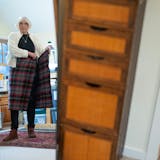Nearly two weeks into Derek Chauvin's trial in the death of George Floyd, the world has watched the vetting of dozens of prospective jurors who will consider whether the former Minneapolis police officer goes to prison.
Not only is the trial historic, but so too is the fact that it can be watched by anyone with a decent internet connection — offering unprecedented access to Minnesota's courts that advocates hope could open the door for future televised sessions.
The livestreaming of the trial has pushed Minnesota into a simmering national debate about televising court proceedings. Minnesota has one of the most restrictive policies in the country, permitting audio and video recordings only after a guilty plea or a guilty verdict.
"This is an opportunity to demonstrate that cameras neither detract from the solemnity of the proceedings nor do they interfere with the court's ability to get on with its work and for the public to see what's being done in the courtroom," said Jane Kirtley, a lawyer and director of the Silha Center for Media Ethics and the Law at the University of Minnesota.
Hennepin County District Judge Peter Cahill issued the order in November, citing the COVID-19 pandemic and international interest in the trial as the reason for livestreaming it. While the order grants unprecedented video access, it also greatly limits physical access to the courtroom.
Attorney General Keith Ellison's office, which is leading the prosecution, fought the order in court, saying that livestreaming could sacrifice the privacy of witnesses and expose them to threats and intimidation. "The risks of broadcasting witness testimony are particularly acute where, as here, live video and audio coverage may be intimidating to some witnesses and make it less likely that they will testify, potentially interfering with a fair trial," the motion said.
A coalition of local and national media companies, including the Star Tribune, filed a memorandum opposing the prosecutors' request, saying that livestreaming is the only option to guarantee constitutional rights to a public trial because the court's closed-circuit technology offers low-quality video and sound.
Cahill dismissed the attorney general's motion, concluding that "televising the trial is the only reasonable and meaningful method to safeguard the [constitutional] rights implicated in these cases."


